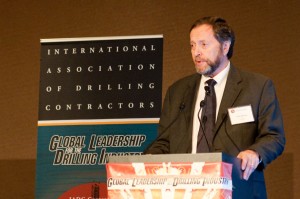New rig designs emerge as industry expands offshore fleet
By Katherine Scott, editorial coordinator

The offshore rig fleet continues to expand at a brisk pace, with most drilling contractors taking a safe approach toward newbuild designs, said Tom Kellock, IHS-Petrodata senior manager, research, at the IADC World Drilling 2012 Conference and Exhibition on 14 June in Barcelona, Spain. “Industry is investing like it’s never done before and in a very significant number of rigs,” he said. However, even in a business that leans toward conservatism, a few companies have dared to be different, with varied results.
In the drillship market, approximately 90% of current newbuilds are from well-established designers such as Samsung and GustoMSC, with deliveries that have largely been on time, Mr Kellock said. He added that almost all of the 100-plus units are being built for the ultra-deepwater, mostly 10,000 ft. “Ultra-deepwater for drillships is pretty much the only way to go,” he said.
Jackup designs, too, have mostly remained the same, with about 90% of new rigs being built on familiar designs from the likes of Keppel FELS and Friede & Goldman. Most units are targeting 350 to 400 ft of water-depth capability, and deliveries have typically been on schedule as well, Mr Kellock said.
Although offshore rigs are still largely being built in either Singapore or South Korea, China is also starting to take a notable share of the rig-building market, not just for jackups but for drillships and semisubmersibles as well, he said. “I don’t think anyone can afford to ignore what’s happening in China. They are rapidly improving the quality of what they do, the range of what they do and their reputation,” Mr Kellock said.
Compared with the jackup and drillship segments, it appears that more risks are being taken with the semisubmersibles sector, indicated by more companies veering from proven designs, Mr Kellock said. About a quarter of semis under construction are being built on non-traditional designs. Water-depth capability is also much more varied. Although the majority of these new semis still target the 7,500-ft to 10,000-ft range, there is a notable percentage of semis aimed for the under-3,000 ft and 5,000-ft to 7,500-ft markets.
For companies that have opted for the newer designs, results have varied. The ENSCO 8500 series is an example of a design risk that paid off, Mr Kellock said. These rigs were built for 8,500-ft water depths instead of the more common 10,000 ft or 12,000 ft, making them “not-quite-ultra deepwater.” This allowed the company to significantly lower the cost of construction – and yet the units have been able to command dayrates on par with floaters that have deeper water-depth capabilities, he noted. This is because the majority of drilling being done today still doesn’t venture out past 8,500 ft, helping the 8500 rigs to remain competitive. “From a dayrate point of view, they haven’t suffered whatsoever from building a slightly less capable, slightly smaller, significantly cheaper rig,” he said.
Sevan Drilling, too, has come up with a unique rig design based on Sevan Marine’s Sevan 650 model, which uses a patented cylindrical hull design. Despite parent company and contractual problems, Sevan Drilling has been improving the outlook of its fleet, Mr Kellock said, stating that Sevan has come up with “the first radical new design for an offshore drilling rig since the 1950s.” The Sevan Driller and Sevan Brasil semis are under contract with Petrobras for six-year fixed terms and are operating in Brazil’s pre-salt. Mr Kellock praised the Brazilian oil giant for its bold moves to try the Sevan design. “Good for Petrobras for taking these rigs,” Mr Kellock said. “You need an operator as well as a contractor to be successful.” Two further newbuilds of the same design are under construction in China’s Cosco shipyard in Guangdong, with expected deliveries in 2013 and 2014, though they are not currently under contract.
Mr Kellock concluded that while customer acceptance and technical and commercial success are not guaranteed when building rigs to newer, more “unproven” designs, innovation is good for the overall business. “Industry does need to innovate. Hats off to the contractors and operators for trying something new,” he said.




